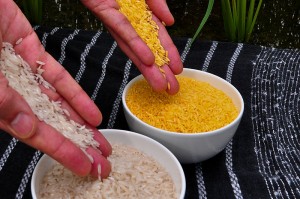GMO foods are safe to eat, but they pose challenges in the environment.
by John Timmer
Canola plants, which have trouble keeping their genes in check.
Many aspects of modern technology make people a bit uneasy, but genetically modified foods may be in a class by themselves. Labs all around the world make genetic modifications of organisms—bacteria, plants, and animals—365 days a year. And some of the results of that work have been ingested by humans for years, often in the form of life-saving drugs. But genetically modified crops remain controversial around the globe, and while they're commonly used in the US, they have almost no presence in the European market.
The worries about GMO foods largely focus on their safety, but much of the debate ignores the extensive studies that have been done to understand both the potential risks and what we've learned about them. In response to this perceived gap in understanding, a group of Italian scientists have now performed a comprehensive review of the scientific literature on GMO crops (we were made aware of the review by Real Clear Science). The results suggest that GMO crops are safe for us, but there are some remaining concerns about their environmental impact that need to be nailed down. In the meantime, the authors suggest that GMOs represent a serious challenge for science communication with the public.
To get a grip on current research, the authors searched databases for any papers on the topic that were published between 2002 and October of 2012; they came up with 1,783 of them. But not all of these spoke directly to safety. The authors note that many of the articles published on GMO crops were commentaries, and the ones that directly addressed safety concerns tended to end up in low-profile publications. Confusing matters further, there were several areas of largely unrelated research that all speak to the safety of these crops.
What you ingest
There's one obvious concern when it comes to GMO crops: we eat them. Are we ingesting anything unusual? To understand that, you have to know how transgenic plants work. They start with a piece of DNA, one that carries a gene of interest—say, one that encodes a protein that provides the plant disease or pest resistance. That DNA is packaged with additional sequences that make sure the gene can be made by plant cells, along with a gene for drug resistance that lets you track whether the DNA is present in cells. The whole package is then inserted into one of the plant's chromosomes.

So DNA, RNA, proteins, and chemicals. That's a lot to worry about, right?
Well, maybe not. Everyone's meals normally contain some DNA, but the average person only ingests between 0.1 and 1 gram of it every day. Most of that is the DNA that all plants and animals naturally contain; estimates are that the engineered DNA accounts for less than 0.00006 percent of the total. Cooking destroys most of it, and the majority of the rest is degraded in the harsh digestive environment.
There's a small chance that some of it will survive long enough to be taken up by gut bacteria, but this is a very uncommon event (otherwise your average E. coli would have a genome swimming with corn and cow DNA). The one potential risk there is that the bacteria will pick up the drug resistance gene that's part of the initial package inserted into the plant, but that poses little risk since biologists use resistance genes that are already widespread in bacterial populations, meaning the drugs aren't used much clinically.
Similar things apply to the RNA and proteins, in that most are fully digested long before they reach the bloodstream. (In fact, the review notes that this is precisely why we have to rely on injections to get protein- and RNA-based therapies into people.) There's been a single report that plant RNA may appear in the bloodstream of mice, but the results haven't been replicated since.
Another risk is that the proteins made by the GMO plant (or some digested fragment of it) will cause an allergic reaction. For that reason, the protein sequences are tested against a large database of common allergens. The proteins are also assessed for toxicity in animals and for their ability to survive a digestive environment. As far as any chemical end products are concerned, they're generally being used precisely because the chemical in question will have a beneficial effect on humans. Because all these risks from DNA, proteins, and chemicals are identical to those posed by unmodified plants, the European Commission has concluded that "the use of biotechnology and of GE plants per se does not imply higher risks than classical breeding methods or production technologies."
The only residual uncertainty is whether the mere presence of the RNA and proteins made by the transgenic DNA alters the plants in a systematic way. In a general sense, they don't; transgenic plants pass what's called a "substantial equivalence" test, which means they are indistinguishable from the crop that they were derived from in terms of nutrients and other key components.
However, if you do a detailed analysis of every protein and chemical produced by the plants (a proteomics and metabolomics study), you can see differences between the transgenics and other crops. But similar things happen if you raise identical crops in slightly different environments, so it's not clear if this is a real result or an experimental glitch—and, if it's the former, whether that tells us anything significant. The review's authors argue that this is an area that deserves further study.
GMOs and the environment
Although it's almost impossible for the genes to spread to humans, that doesn't mean they can't spread. Crops are grown in uncontrolled environments, where they come in contact with other species, some of which can be close relatives. For most species, this DNA doesn't provide any advantages that can't be provided by the DNA that's already present in the environment. Bacteria and insects won't benefit from picking up genes for herbicide resistance or insect-killing proteins. The drug resistance could benefit the bacteria, except the genes in use are already widespread in soil communities. And at least so far, field studies haven't found any evidence of transgenes ending up in soil bacteria.
The same cannot be said for plants, or at least those plants that are closely related to crops. There have been reports of a strain of canola that contains multiple herbicide resistance genes, which presumably came about through the hybridizing of two or more GM strains. Obviously, the transgene would provide a survival advantage for any plant that was growing near agricultural areas. The same would be true for the spread of genes that encode proteins that are toxic to insects, except the latter would provide a survival advantage just about anywhere.
These genes could also cause problems for agriculture itself. Currently, resistance to insecticidal proteins like Bt is limited in part by careful crop management. If wild plants pick up the same gene, it could hasten the evolution of resistant insects regardless of how the crops are managed. Although there are some ideas about how to limit the spread, there are problems with all of them: "none of them can be considered completely effective for transgene containment and complete segregation of GE [genetically engineered] crops is not possible."
Communication breakdown
The conclusion of the review is that from the perspective of human consumption, all evidence indicates that GMO foods are safe; the primary risks are to agriculture itself, primarily from the unintended spread of some of the transgenes to wild populations.
But that's hardly the impression you'd get from the public debate. GM foods are often portrayed as untested or their safety a complete unknown. Rare, unreproducible results are often trumpeted as the final word. These are features that are shared with a number of other areas where there's been a failure of science communication, and the authors argue that scientists themselves share the blame here: "the frequent non-scientific disputes in the media that are not balanced by an effective communication from the scientific and academic world, greatly contribute to enhance the concerns on GE crops."
But the review points out that effective communication is hard because the scientific community is never 100 percent unified. The authors note that there is "animated debate regarding the suitability of the experimental designs, the choice of the statistical methods, or the public accessibility of data," and that's all a healthy sign that science is following its normal course here, even as its conclusions firm up. Unfortunately, this healthy debate has "frequently been distorted by the media and often used politically and inappropriately in anti-GE crops campaigns."
All of which makes getting the big picture—GM foods appear safe to eat—a difficult message to elevate above the noise.
Courtesy: arstechnica



0 comments:
Post a Comment